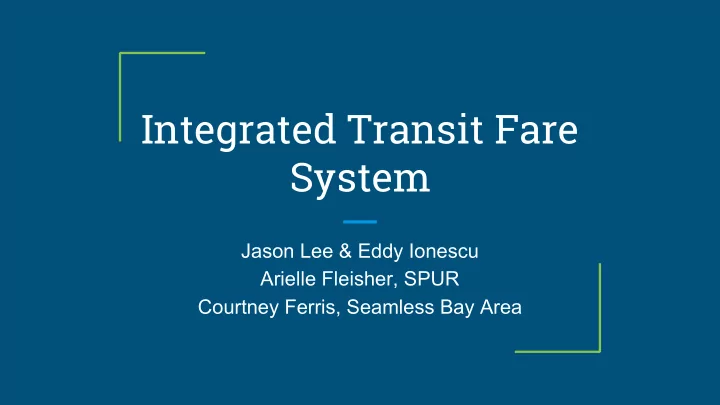

Integrated Transit Fare System Jason Lee & Eddy Ionescu Arielle Fleisher, SPUR Courtney Ferris, Seamless Bay Area
Inconsistent Fare Policies
1. Transfer Tax Hidden Taxes 2. Flexibility Tax 3. Mode Tax Increase inequality and are a barrier to taking transit
Transfer Tax Minimal to no fare credit when transferring between systems Imposes penalties on people who use multiple transit systems, including those who cannot afford to live close to rail stations
Operator Origin-Destination Current Proposed Clipper Clipper Fare Fare AC Transit East Oakland-Coliseum BART $2.25 $2.25 BART Coliseum-Embarcadero $4.55 $2.30 ($2.25 credit) Muni Embarcadero-Mission Bay $2.00 (50¢ Free credit) ($2.00<$4.55) Total $8.80 $4.55* *$170.63 monthly with 6.25% BART discount (from $323.85)
Flexibility Tax No pass credit when using another agency for interchangeable trips Forces people to commit to one agency even when it is not optimal
Operator Origin-Destination Current Proposed Clipper Fare Clipper Fare AC Transit Salesforce Transit Center - $4.50 $4.50 Princeton Plaza Total $4.50 $4.50 *$162 monthly transbay pass
Operator Origin-Destination Current Proposed Clipper Fare Clipper Fare BART Embarcadero - El Cerrito del $4.55 $0.05 Norte AC Transit El Cerrito del Norte - Princeton $0 $0 Plaza Total $4.55 $0.05 *$162 monthly AC transbay pass + $4.55 on weekends when the L Transbay bus does not operate
Mode Tax Different fares for services with similar levels of service Requires people to choose less than ideal options and/or transit agencies to provide duplicative service
Operator Origin-Destination Mileage Current Proposed Clipper Clipper Fare Fare $4.55 Caltrain Mountain View-Millbrae 22.4 $5.45 $5.45 BART Millbrae-SFO 1.6 $4.55 Free ($4.55<$5.45) Total $10.00 $5.45 $5.45
Operator Origin-Destination Mileage Clipper Fare $2.05 Caltrain Mountain View-Millbrae 22.4 $5.45 SamTrans Millbrae-SFO 1.6 $2.05 Total $7.50 $5.45
Geographical Inequality Hidden taxes are most burdensome on Communities of Concern
Proposed Pass and Transfer Policies • Pay the max fare instead of the sum of all fares • Day and monthly passes valid for any and all transit agencies within the nine- county region, including for BART and Golden Gate Transit • Day and monthly pass prices would be capped at a regionally-determined multiplier of the single-ride price • Fare structure is not dependent on a unified fare zones or pricing among agencies
What can we learn from other regions? ● Several regions around the world have integrated their transit fares and/or developed multi-operator products: Seattle, Portland, New South Wales, London, & Toronto ● Key lessons learned: ○ Fare integration is possible ○ Reducing barriers to transferring promotes complete journeys ○ Fare simplification can boost transit ridership ○ Fare policy can be a tool for transit affordability
Potential Outcomes from Changes to Fare Policy ● Improve customer experience ● Increase trust and and customer satisfaction ● Improve reliability ● Cost savings to passengers ● Grow region-wide transit ridership, in particular in markets where the existing fare structures suppress demand ● Optimize use of the Bay Area’s complete transit network ● Increase transit competitiveness ● Enhance social equity
What does it take to implement fare integration? Leadership Governance ● Set the long term vision ● Negotiation/ cooperation ● Build stakeholder support ● Regulation ● Central authority Funding User-centered design process ● Cover revenue shortfalls ● Fare payment ● Deep understanding of rider infrastructure changes needs ● Feedback/ communication
Summary Fare integration unlocks opportunities to make transit more predictable and coherent for customers - Branding Integration - Service Integration
In assigning a “cost/benefit” score, let’s not underestimate the benefits
Thank You Jason Lee & Eddy Ionescu Arielle Fleisher, SPUR Courtney Ferris, Seamless Bay Area We look forward to partnering with MTC on analyzing and improving Regional Fare Integration
Recommend
More recommend